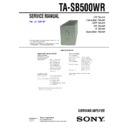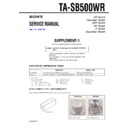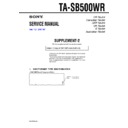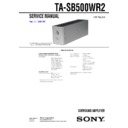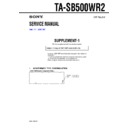Read Sony TA-SB500WR Service Manual online
SERVICE MANUAL
SURROUND AMPLIFIER
US Model
Canadian Model
AEP Model
UK Model
E Model
Australian Model
SPECIFICATIONS
TA-SB500WR
Ver. 1.2 2007.07
9-879-016-03
2007G05-1
© 2007.07
© 2007.07
Sony Corporation
Home Audio Division
Published by Sony Techno Create Corporation
Published by Sony Techno Create Corporation
•
TA-SB500WR is the amplifier section in DAV-DZ531W/
LF10/SB500W/WAHT-SD1.
LF10/SB500W/WAHT-SD1.
•
Refer to the supplement-1 of this service manual for
TA-SB500WR in DAV-DZ531W/WAHT-SD1.
TA-SB500WR in DAV-DZ531W/WAHT-SD1.
AUDIO POWER SPECIFICATIONS
for the US model
for the US model
POWER OUTPUT AND
TOTAL HARMONIC
DISTORTION:
TOTAL HARMONIC
DISTORTION:
With 4 ohm loads, both
channels driven, from
200 – 20,000 Hz; rated
65 watts per channel
minimum RMS power,
with no more than 0.7 %
total harmonic distortion
from 250 milli watts to
rated output.
channels driven, from
200 – 20,000 Hz; rated
65 watts per channel
minimum RMS power,
with no more than 0.7 %
total harmonic distortion
from 250 milli watts to
rated output.
Amplifier section
Stereo mode (rated)
86 W + 86 W (4 ohms at
1 kHz, THD 10 %)
1 kHz, THD 10 %)
Surround mode (reference) music power output
for DAV-LF10:
86 W*
(with SS-TSL11)
for DAV-SB500W: 96 W + 96 W*
(with SS-TS11)
for DAV-SB500W: 96 W + 96 W*
(with SS-TS11)
* Depending on the sound field settings and the source,
there may be no sound output.
Surround amplifier
Power requirements
North American models:
North American models:
120 V AC, 60 Hz
Taiwan model:
120 V AC, 50/60 Hz
Other models:
220-240 V AC, 50/60 Hz
Power consumption
36 W (120 V AC)
36 W (220-240 V AC)
36 W (220-240 V AC)
Dimensions (approx.)
65
×
90
×
335 mm
(2
5
/
8
×
3
5
/
8
×
13
1
/
4
inches) (w/h/d) incl.
speaker cord cover
speaker cord cover
Mass (approx.)
1.3 kg (2 lb 14 oz)
Design and specifications are subject to change
without notice.
without notice.
2
TA-SB500WR
TABLE OF CONTENTS
1.
GENERAL
...................................................................
3
2.
DISASSEMBLY
2-1.
Disassembly Flow ...........................................................
4
2-2.
Wire Cover ......................................................................
4
2-3.
Top Panel .........................................................................
5
2-4.
Side Panel, Front Panel Section .......................................
5
2-5.
DIAT POWER Board ......................................................
6
2-6.
DIAT AMP Board ............................................................
6
3.
DIAGRAMS
3-1.
Block Diagram ................................................................
7
3-2.
Schematic Diagram – DIAT AMP Board (1/3) – ...........
9
3-3.
Schematic Diagram – DIAT AMP Board (2/3) – ........... 10
3-4.
Schematic Diagram – DIAT AMP Board (3/3) – ........... 11
3-5.
Printed Wiring Board
– DIAT AMP Board (Component Side) – ....................... 12
– DIAT AMP Board (Component Side) – ....................... 12
3-6.
Printed Wiring Board
– DIAT AMP Board (Conductor Side) – ......................... 13
– DIAT AMP Board (Conductor Side) – ......................... 13
3-7.
Printed Wiring Boards – POWER SUPPLY Section – ... 14
3-8.
Schematic Diagram – POWER SUPPLY Section – ....... 15
4.
EXPLODED VIEWS
4-1.
Panel Section ................................................................... 20
4-2.
DIAT AMP/DIAT POWER Boards Section .................... 21
5.
ELECTRICAL PARTS LIST
................................ 22
Notes on chip component replacement
•
Never reuse a disconnected chip component.
•
Notice that the minus side of a tantalum capacitor may be
damaged by heat.
SAFETY-RELATED COMPONENT WARNING!!
COMPONENTS IDENTIFIED BY MARK
0
OR DOTTED LINE
WITH MARK
0
ON THE SCHEMATIC DIAGRAMS AND IN
THE PARTS LIST ARE CRITICAL TO SAFE OPERATION.
REPLACE THESE COMPONENTS WITH SONY PARTS WHOSE
PART NUMBERS APPEAR AS SHOWN IN THIS MANUAL OR
IN SUPPLEMENTS PUBLISHED BY SONY.
REPLACE THESE COMPONENTS WITH SONY PARTS WHOSE
PART NUMBERS APPEAR AS SHOWN IN THIS MANUAL OR
IN SUPPLEMENTS PUBLISHED BY SONY.
UNLEADED SOLDER
Boards requiring use of unleaded solder are printed with the lead-
free mark (LF) indicating the solder contains no lead.
(Caution: Some printed circuit boards may not come printed with
free mark (LF) indicating the solder contains no lead.
(Caution: Some printed circuit boards may not come printed with
the lead free mark due to their particular size)
: LEAD FREE MARK
Unleaded solder has the following characteristics.
•
Unleaded solder melts at a temperature about 40
°
C higher
than ordinary solder.
Ordinary soldering irons can be used but the iron tip has to be
applied to the solder joint for a slightly longer time.
Soldering irons using a temperature regulator should be set to
about 350
°
C.
Caution: The printed pattern (copper foil) may peel away if
the heated tip is applied for too long, so be careful!
•
Strong viscosity
Unleaded solder is more viscou-s (sticky, less prone to flow)
Unleaded solder is more viscou-s (sticky, less prone to flow)
than ordinary solder so use caution not to let solder bridges
occur such as on IC pins, etc.
occur such as on IC pins, etc.
•
Usable with ordinary solder
It is best to use only unleaded solder but unleaded solder may
It is best to use only unleaded solder but unleaded solder may
also be added to ordinary solder.
ATTENTION AU COMPOSANT AYANT RAPPORT
À LA SÉCURITÉ!
LES COMPOSANTS IDENTIFIÉS PAR UNE MARQUE
0
SUR
LES DIAGRAMMES SCHÉMATIQUES ET LA LISTE DES
PIÈCES SONT CRITIQUES POUR LA SÉCURITÉ DE
FONCTIONNEMENT. NE REMPLACER CES COM- POSANTS
QUE PAR DES PIÈCES SONY DONT LES NUMÉROS SONT
DONNÉS DANS CE MANUEL OU DANS LES SUPPLÉMENTS
PUBLIÉS PAR SONY.
PIÈCES SONT CRITIQUES POUR LA SÉCURITÉ DE
FONCTIONNEMENT. NE REMPLACER CES COM- POSANTS
QUE PAR DES PIÈCES SONY DONT LES NUMÉROS SONT
DONNÉS DANS CE MANUEL OU DANS LES SUPPLÉMENTS
PUBLIÉS PAR SONY.
SAFETY CHECK-OUT
After correcting the original service problem, perform the following
safety check before releasing the set to the customer:
Check the antenna terminals, metal trim, “metallized” knobs, screws,
and all other exposed metal parts for AC leakage.
Check leakage as described below.
safety check before releasing the set to the customer:
Check the antenna terminals, metal trim, “metallized” knobs, screws,
and all other exposed metal parts for AC leakage.
Check leakage as described below.
LEAKAGE TEST
The AC leakage from any exposed metal part to earth ground and
from all exposed metal parts to any exposed metal part having a
return to chassis, must not exceed 0.5 mA (500 microamperes.).
Leakage current can be measured by any one of three methods.
from all exposed metal parts to any exposed metal part having a
return to chassis, must not exceed 0.5 mA (500 microamperes.).
Leakage current can be measured by any one of three methods.
1. A commercial leakage tester, such as the Simpson 229 or RCA
WT-540A. Follow the manufacturers’ instructions to use these
instruments.
instruments.
2. A battery-operated AC milliammeter. The Data Precision 245
digital multimeter is suitable for this job.
3. Measuring the voltage drop across a resistor by means of a
VOM or battery-operated AC voltmeter. The “limit” indication
is 0.75 V, so analog meters must have an accurate low-voltage
scale. The Simpson 250 and Sanwa SH-63Trd are examples
of a passive VOM that is suitable. Nearly all battery operated
digital multimeters that have a 2 V AC range are suitable. (See
Fig. A)
is 0.75 V, so analog meters must have an accurate low-voltage
scale. The Simpson 250 and Sanwa SH-63Trd are examples
of a passive VOM that is suitable. Nearly all battery operated
digital multimeters that have a 2 V AC range are suitable. (See
Fig. A)
Fig. A.
Using an AC voltmeter to check AC leakage.
1.5 k
Ω
0.15
µ
F
AC
voltmeter
(0.75 V)
voltmeter
(0.75 V)
To Exposed Metal
Parts on Set
Parts on Set
Earth Ground
3
TA-SB500WR
SECTION 1
GENERAL
This section is extracted from
instruction manual.
instruction manual.
Surround amplifier
A POWER
B POWER/ON LINE indicator
C DIR-R1 jack
D SPEAKER jacks
B POWER/ON LINE indicator
C DIR-R1 jack
D SPEAKER jacks
DIR-R1
SPEAKER
SURROUND
L
SURROUND
R
POWER
POWER ON-LINE
Front panel
Rear panel
LOCATION OF CONTROLS
TA-SB500WR
4
Note:
Follow the disassembly procedure in the numerical order given.
2-2. WIRE COVER
•
This set can be disassembled in the order shown below.
2-1. DISASSEMBLY FLOW
SECTION 2
DISASSEMBLY
2-2. WIRE COVER
(Page 4)
2-3. TOP PANEL
(Page 5)
2-4. SIDE PANEL,
FRONT PANEL SECTION
(Page 5)
(Page 5)
2-5. DIAT POWER BOARD
(Page 6)
2-6. DIAT AMP BOARD
(Page 6)
SET
4
wire cover
3
two claws
2
wire (A) holder
1
screw (B3
×
8)

